Σπήλαιο Στραβομύτη | |
| Location | Crete |
|---|---|
| Region | Greece |
| Coordinates | 35°15′0″N25°8′59.9″E / 35.25000°N 25.149972°E |
Stravomyti Cave is an ancient Minoan cave on Crete.
Σπήλαιο Στραβομύτη | |
| Location | Crete |
|---|---|
| Region | Greece |
| Coordinates | 35°15′0″N25°8′59.9″E / 35.25000°N 25.149972°E |
Stravomyti Cave is an ancient Minoan cave on Crete.
Stravomyti Cave is 400 meters above sea level on Mt. Juktas' southwest slope.
Stravomyti Cave first saw use during Neolithic times, as a refuge and burial. During the Early Minoan period, the quality of pottery suggests that people lived in the caves. Thereafter, it was used for storage and worship.
The cave may have once been a shrine to a female deity - Artemis, Diktynna or perhaps Eileithyia.
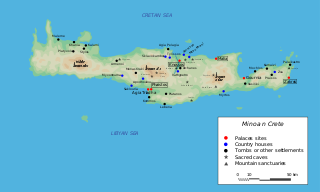
The Minoan civilization was a Bronze Age culture which was centered on the island of Crete. Known for its monumental architecture and energetic art, it is often regarded as the first civilization in Europe. The ruins of the Minoan palaces at Knossos and Phaistos are popular tourist attractions.
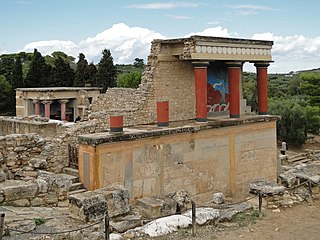
Knossos is a Bronze Age archaeological site in Crete. The site was a major centre of the Minoan civilization and is known for its association with the Greek myth of Theseus and the minotaur. It is located on the outskirts of Heraklion, and remains a popular tourist destination. Knossos is considered by many to be the oldest city in Europe.

Phaistos, also transliterated as Phaestos, Festos and Latin Phaestus, is a Bronze Age archaeological site at modern Faistos, a municipality in south central Crete. It is notable for the remains of a Minoan palace and the surrounding town.

Zakros is a Minoan archaeological site on the eastern coast of Crete in Lasithi, Greece. It is regarded as one of the six Minoan palaces, and its protected harbor and strategic location made it an important commercial hub for trade to the east.
In Greek mythology, two sacred mountains are called Mount Ida, the "Mountain of the Goddess": Mount Ida in Crete, and Mount Ida in the ancient Troad region of western Anatolia, which was also known as the Phrygian Ida in classical antiquity and is mentioned in the Iliad of Homer and the Aeneid of Virgil. Both are associated with the mother goddess in the deepest layers of pre-Greek myth, in that Mount Ida in Anatolia was sacred to Cybele, who is sometimes called Mater Idaea, while Rhea, often identified with Cybele, put the infant Zeus to nurse with Amaltheia at Mount Ida in Crete. Thereafter, his birthplace was sacred to Zeus, the king and father of Greek gods and goddesses.

A mountain in north-central Crete, Mount Juktas, also spelled Iuktas, Iouktas, or Ioukhtas, was an important religious site for the Minoan civilization. Located a few kilometers from the palaces of Knossos and Fourni and the megaron at Vathypetro, Mount Juktas was the site of an important peak sanctuary in the Minoan world. At the base of Juktas, at Anemospilia, is a site that has suggested to some that the Minoans practiced human sacrifice, but the evidence is currently somewhat in question.

Mount Ida, known variously as Idha, Ídhi, Idi, and Ita, is the highest mountain on the island of Crete, with an elevation of 2,456 metres (8,058 ft). It has the highest topographic prominence of any mountain in Greece. A natural park which includes Mount Ida is a member of UNESCO's Global Geoparks Network.

The Minoan civilization produced a wide variety of richly decorated Minoan pottery. Its restless sequence of quirky maturing artistic styles reveals something of Minoan patrons' pleasure in novelty while they assist archaeologists in assigning relative dates to the strata of their sites. Pots that contained oils and ointments, exported from 18th century BC Crete, have been found at sites through the Aegean islands and mainland Greece, in Cyprus, along coastal Syria and in Egypt, showing the wide trading contacts of the Minoans.

Minoan peak sanctuaries are widespread throughout the island of Crete (Greece). Most scholars agree that peak sanctuaries were used for religious rites high in the mountains of Crete. Human and animal figurines, as well as signs of religious architecture, have been found at most peak sanctuaries. Additionally, votive clay body parts are found at many of these sites. Many of the sanctuaries fell out of use during the Late Bronze Age, when Mycenaeans from the Greek mainland became the dominant culture on the island.

Petsofas is the archaeological site of a Minoan peak sanctuary in eastern Crete. It overlooks the Minoan town of Palaikastro and was excavated by John Myres in 1903. He discovered a large number of clay figurines, including animal and human figures dating to 1400 to 1450.

Sacred caves and peak sanctuaries are characteristic holy places of ancient Minoan Crete. Most scholars agree that sacred caves were used by the Minoans for religious rites, and some for burial. While all peak sanctuaries have clay human figurines, only Idaeon, Trapeza and Psychro have them among the sacred caves. Clay body parts, also called votive body parts, common among peak sanctuaries, appear in no caves with the exception of a bronze leg in Psychro.
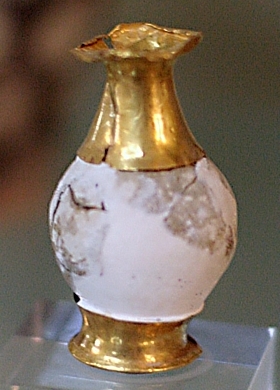
Kamares is a village in south-central Crete, Greece. It is the location of an archaeological site of a Minoan sacred cave. The sacred cave at Kamares is slightly offset from a saddle in the Psiloriti Range virtually aligned with the location of nearby Phaistos. Some of the best examples of Middle Minoan pottery have been recovered from the Kamares cave. Kamares has provided the type name for Kamares ware, a ceramic type dating from MM IA, or the First Palace Period. This pottery is a light-on-dark polychrome ware, with forms including jugs and cups.

Psychro Cave is an ancient Minoan sacred cave in Lasithi plateau in the Lasithi district of eastern Crete. Psychro is associated with the Diktaean Cave, one of the putative sites of the birth of Zeus. Other legends place Zeus' birthplace as Idaean Cave on Mount Ida. According to Hesiod, Theogony, Rhea gave birth to Zeus in Lyctus and hid him in a cave of Mount Aegaeon. Since the late nineteenth century the cave above the modern village of Psychro has been identified with Diktaean Cave, although there are other candidates, especially a cave above Palaikastro on Mount Petsofas.
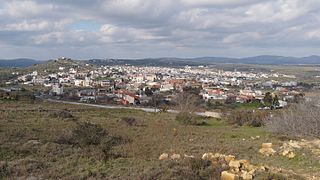
Arkalochori is a town and a former municipality in the Heraklion regional unit, Crete, Greece. Since the 2011 local government reform it is part of the municipality Minoa Pediada, of which it is a municipal unit. The municipal unit has an area of 237.589 km2 (91.734 sq mi).

Tylissos is a town and a former municipality in the Heraklion regional unit, Crete, Greece. Since the 2011 local government reform it is part of the municipality Malevizi, of which it is a municipal unit. The municipal unit has an area of 131.064 km2 (50.604 sq mi). Population 2,252 in 2021. It is an ancient Minoan peak sanctuary and town. The Municipality of Tylisos was created in 1999 and includes 11 villages. The economy is based on agriculture, mainly grape cultivation and olive cultivation. At the same time stock farming of sheep, goats and chickens and beehive farms are abundant.
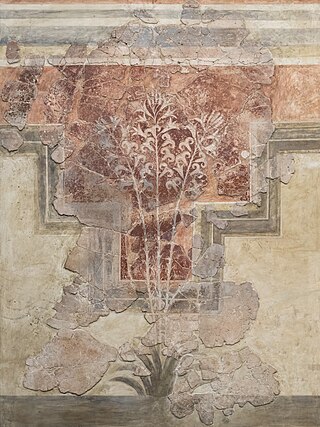
Amnisos, also Amnissos and Amnisus, is the current but unattested name given to a Bronze Age settlement on the north shore of Crete that was used as a port to the palace city of Knossos. It appears in Greek literature and mythology from the earliest times, but its origin is far earlier, in prehistory. The historic settlement belonged to a civilization now called Minoan. Excavations at Amnissos in 1932 uncovered a villa that included the "House of the Lilies", which was named for the lily theme that was depicted in a wall fresco.

Eileithyia Cave was a sacred cave dedicated to the goddess of childbirth, Eileithyia, on the island of Crete, that was used from the Neolithic era to the Roman, with worship flourishing in the Late Minoan period. It has been suggested that rock formations within the cave resemble female figures, most prominently a stalagmite in the centre that appears as a standing female.

The Heraklion Archaeological Museum is a museum located in Heraklion on Crete. It is one of the largest museums in Greece and the best in the world for Minoan art, as it contains by far the most important and complete collection of artefacts of the Minoan civilization of Crete. It is normally referred to scholarship in English as "AMH", a form still sometimes used by the museum in itself.

The Lasithi Plateau is a high endorheic plateau, located in the Lasithi regional unit in eastern Crete, Greece. Since the 1997 Kapodistrias reform, it is a municipality whose seat is Tzermiado and the second biggest village is Agios Georgios. The municipality has an area of 129.9 km2.

Trapeza, Crete is a Neolithic and Bronze Age sacred cave on the island of Crete in Greece. Some of the Bronze Age pottery finds at Trapeza are similar to specimens recovered at Knossos and Vasiliki.